| If you want to get your work out on paper, you can use many types of printers to get the job done. Under Mac OS X, you install and manage printers using the Printer Setup Utility application. And Mac OS X includes support for a large number of printers by default. Four basic categories of printers are available, based on the technology the printer uses to imprint the paper: Inkjet Inkjet printers spray small dots of ink on the paper to form images and text. Inkjet printers produce excellent quality text and good-to-excellent quality graphics. For personal printers or those shared by only a few people, inkjets are hard to beat. A good quality inkjet printer costs less than $150, so they are also an excellent value. Support for many Hewlett-Packard, Lexmark, Epson, and Canon inkjet printers is built in to Mac OS X. Laser Laser printers produce superb quality for both text and graphics. They are also very fast and are the best choice for network printing. Lower-end laser printers are affordable enough to also be a good choice for a personal printer. Color laser Color laser printers produce excellent text and graphics and also have color capability. High-quality color laser printers are very expensive and are unlikely to be an option for you unless high-quality color printing and network support are required and you have a business that can justify their expense. Other printers Beyond color laser printers are dye-sublimation and other higher-quality printers that are used in graphic design and other high-end businesses.
NOTE A factor to consider when selecting a printer is that inkjets use a lot of ink and cartridges are expensive. If you do much black-and-white printing, a laser printer can be a less expensive option in the long run when you consider the cost of the consumable supplies (ink versus toner).
There are two ways you can connect a printer to your Mac: directly or through a network. To connect a printer directly to your Mac, you simply attach the printer cable to the appropriate port on your Mac (USB or Ethernet for newer Macs; serial or Ethernet for older Macs). How you connect a printer to your network depends on the type of network you are using. If you are using an Ethernet network, you can attach a cable from the nearest hub or print server to your printer. You can also choose to share either type of printer over a wired or wireless network. Mac OS X supports several printer communication protocols, including AppleTalk, IP Printing, Open Directory, Bonjour, direct connection through USB, and Windows Printing. Choosing a Printer Covering the mind-boggling variety of printers available is beyond the scope of this book. However, there are some printer classes you might want to consider, including Inkjet A good-quality inkjet printer will serve almost everyone. Even the inexpensive models can do a great job with text and graphics, including printing photos and other high-resolution images. If your page quantity needs are fairly modest, an inkjet printer is a good choice, especially if you need color output. Laser If you have higher quantity demands or your printer needs to support several users, a laser printer might be a better choice. Laser printers are faster and less expensive per page than are inkjets. Many laser printers are networkable so supporting your local network with a single printer is easy. Other options If you have the need for a color laser printer or dye-sub printer, you are probably in a company that has an IT staff that handles obtaining and installing these devices. As long as the printer uses standard network printer drivers, Mac OS X machines will be capable of printing to them just fine.
NOTE Mac OS X easily supports multiple printers at the same time. An ideal setup is to have an inkjet printer for color work, such as printing photos, and a laser printer for documents.
Mac OS X includes support for Bonjour; this technology enables your Mac to actively seek devices to which it is networked. In the case of Bonjour printers, your Mac can discover the printers it can access and automatically configure itself to use those printers. No configuration on your part is required. However, printers have to be Bonjour capable for this to work. Even though Bonjour has been supported since Mac OS X version 10.2, few printers support this technology. Installing Printers There are many types of printers you can install, configure, and use with Mac OS X. In this section, you will learn how to work with the most common types of printers. Installing a Local USB Printer As long as it offers Mac OS Xcompatible drivers, you can install and use just about any USB printer. Using such devices is relatively straightforward: 1. | Connect the printer to the power supply and to your Mac's USB port.
| 2. | Install the printer driver software, if necessary. If the printer you are using is an inkjet from HP, Lexmark, Canon, or Epson, the drivers are probably already built in to Mac OS X.
TIP To see which specific printer models are supported natively by Mac OS X, open Mac OS X/Library/Printers, where Mac OS X is the name of your Mac OS X startup volume. You will see folders for each brand of printer you elected to include when you installed Mac OS X. | 3. | Configure the printer in the Mac OS X Printer Setup Utility.
|
Support for many inkjet printers is built in to Mac OS X. For example, you can use the following steps to install, configure, and use an HP Photosmart inkjet. Other models of inkjet printers work similarly: 1. | Connect power to the printer.
| 2. | Connect the printer's USB cable to a USB port on your Mac.
NOTE If support for the specific model of printer you are using is not built in to Mac OS X, you need to install its specific software prior to configuring the printer on your Mac. | 3. | If the printer has Mac OS Xcompatible software, install itsupport for several printers is built in to the operating system.
| 4. | Open the Printer Setup Utility (Applications/Utilities).
| 5. | In the Printer List window's toolbar, click Add. The Printer Browser will appear. In the upper pane of this window, you will see a list of all the printers with which your Mac can communicate, such as a printer connected to its USB port.
| 6. | Select the printer you want to configure by clicking its name in the list. Information about that printer will be gathered, and Mac OS X will attempt to choose the best driver software for it, which will be shown on the Print Using pop-up menu (see Figure 30.12).
Figure 30.12. Mac OS X can configure most printers automatically, as it did for this one when I selected the "photo-smart 7700 series" on the printer list. 
| 7. | If you don't want to use the default printer name shown in the Name box, select it and type a new name.
| 8. | If the default location isn't what you want, select it and change that, too.
| 9. | If Mac OS X found a driver for your printer and selected it on the Print Using pop-up menu, leave that selection as it is; if a driver wasn't found, open the pop-up menu and choose the appropriate driver. If you can't find a driver for your printer, you need to get one from the printer's manufacturer.
| 10. | Click Add. You'll return to the Printer List and the printer you selected and configured will appear on the list (see Figure 30.13). The printer will be ready to print your documents. The printer you installed most recently will become the default printer, which is indicated by its name being bolded on the list.
Figure 30.13. An HP Photosmart printer has been installed on this Mac. 
|
TIP If you hold down the  key and click the Hide/Show Toolbar button in the Printer List window, you cycle through toolbar configurations, including various icon sizes and a text-only toolbar. key and click the Hide/Show Toolbar button in the Printer List window, you cycle through toolbar configurations, including various icon sizes and a text-only toolbar.
Installing a Network Printer Using a network printer is a good way to share a printer among multiple users; with the rise of home networks and the decrease in the cost of networkable printers, installing a networked printer in a home or home office is also a practical option. Installing a network printer is similar to installing a local printer. The specific steps you use depend on the network you are using and the particular printer model. Support for most laser printers is built in to Mac OS X. In the following example, an HP LaserJet 2200DN is installed on a small Ethernet network. The steps to install other printers on different types of networks are similar: 1. | Connect power to the printer.
| 2. | Connect the printer to an Ethernet hub.
| 3. | If the printer has Mac OS Xcompatible software, install itsupport for most laser printers is built in to the operating system.
| 4. | Open the Printer Setup Utility(Applications/Utilities).
| 5. | In the Printer List window's toolbar, click Add. The Printer Browser will appear. It will begin to search for printers with which your Mac can communicate. The printers it finds will be shown on the printer list.
| 6. | Select the printer you want to install. Mac OS X will attempt to find the driver and configure the printer. If it can do so, you will see the printer's name, its location, and the driver Mac OS X has selected.
| 7. | Click Add. The printer will be added to the Mac and you will return to the Printer List, where each printer installed will be shown (see Figure 30.14).
Figure 30.14. This Mac now has access to two printers available to it. 
|
Installing Other Types of Printers Mac OS X supports many types of printers connected in a lot of ways. Although you are most likely to use a printer connected directly to your Mac or through a networkin which case the Printer Browser will likely do most of the configuration work for youyou might have a more unusual situation, such as wanting to use Bluetooth to print. In the event that the Printer Browser doesn't automatically find and configure a printer, you can use its advanced tools to do the configuring: 1. | Open the Printer Setup Utility and click the Add button in its toolbar. The Printer Browser will appear.
| 2. | If the printer you want to install doesn't appear in the list, click the More Printers button. A printer configuration sheet will appear.
| 3. | On the top pop-up menu, choose the type of printer connection or printer you want to install. For example, if you have a Bluetooth printer available, choose Bluetooth (see Figure 30.15). You can also choose AppleTalk to configure a printer using the AppleTalk protocol or Windows Printing to choose a printer managed by Windows computers. You will also see the printer drivers you elected to install when you installed Mac OS X.
Figure 30.15. Choosing an option on this menu causes your Mac to search for printers according to the protocol you select. 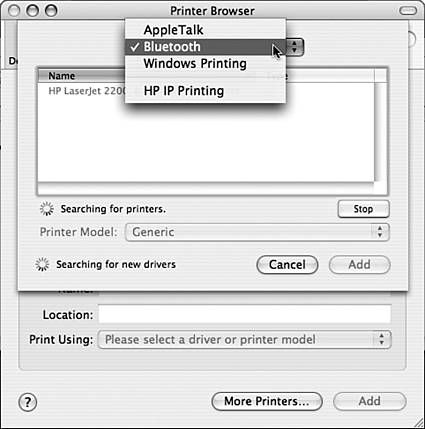
Your Mac will attempt to find a printer according to your selection. If it is successful, the printer will be shown in the resulting printer list. If it can't find the printer, your Mac can't communicate with it. You'll need to correct the issue before you can install the printer on your Mac.
| 4. | If the correct driver isn't selected automatically, choose it on the Printer Model pop-up menu.
TIP If the driver for your printer isn't listed, you'll need to download and install it. Fortunately, Mac OS X supports many kinds of printers by default so unless your printer is older, you shouldn't have to do this. | 5. | Click Add. The printer will be installed on your Mac and you will see it on the Printer List.
|
NOTE If you have access to a printer that uses IP printing, click the IP Printer button on the Printer Browser's toolbar. Then use the resulting sheet to configure the printer, such as entering its IP address.
Managing Printers The Printer Setup Utility enables you to manage the printers configured for your Mac. The tools on its toolbar include the following: Default Select a printer on the list and click the Make Default button to make that printer the default. Delete To remove a printer from your Mac, select it on the list and click the Delete button. The printer will be removed from the list and you will no longer be able to print to it. Utility If the printer can access additional configuration software, when you select it on the list, the Utility button will become active. Click this button to launch the software and use its tools (see Figure 30.16). Figure 30.16. You can use a printer's utility software to work it, such as to monitor its ink levels. 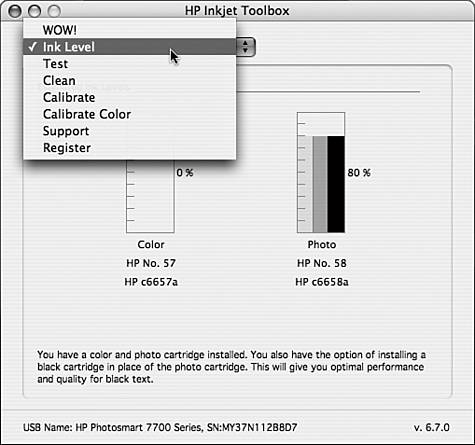
ColorSync This button enables you to configure a ColorSync profile for a printer. Info If you select a printer and click Show Info, the Info window for that printer will appear (see Figure 30.17). Choose the information with which you want to work on from the pop-up menu at the top of the window. The choices include Name & Location, Printer Model, and Installable Options. Use the Name & Location option to view or change this label information for the printer. Use the Pinter Model option to view or change the driver being used. Select Installable Options to configure the printer's features, such as the paper source, duplexing options, and so on. If you make changes, click Apply Changes to save them. Figure 30.17. Use the Info window to view a printer's current information and to change it as needed. 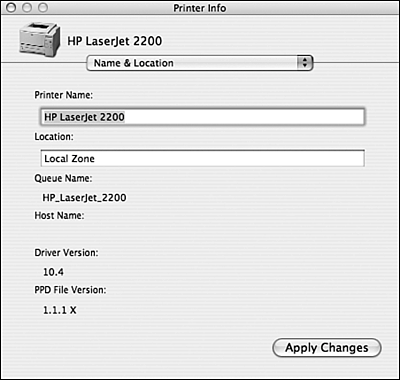
Configure Printer Preferences  | You can set various printer preferences with the Printer tab of the Print & Fax pane of the System Preferences application (see Figure 30.18). In the left part of this tab, you will see the printers installed on your Mac. In the right part of the tab, you'll see information about the selected printer. Underneath these two areas are a number of controls you can use to set your printing preferences. This include the following: |
If the In Menu check box for a printer is checked, that printer will appear in the Print dialog box and can be used. If not, it can't be selected or used. Click the Add button (+) to add a new printer. This will take you to the Printer Browser. Select a printer and click the Delete button (-) to remove it. Select a printer and click Print Queue to open its Print Queue window (more on this later in the chapter). Select a printer and click Printer Setup to open its Info window. Use the "Selected Printer in Print Dialog" pop-up menu to determine which printer is selected automatically in the Print dialog box. The "Last Printer Used" selection will cause the dialog box to remember the last printer you printed with. If you choose one of the installed printers, that printer will be selected each time you print. Use the "Default Paper Size in Page Setup" to choose the size of paper that will be selected in the Page Setup dialog box for the selected printer.
Figure 30.18. Use the Printing tab of the Print & Fax pane to set printer preferences for your system. 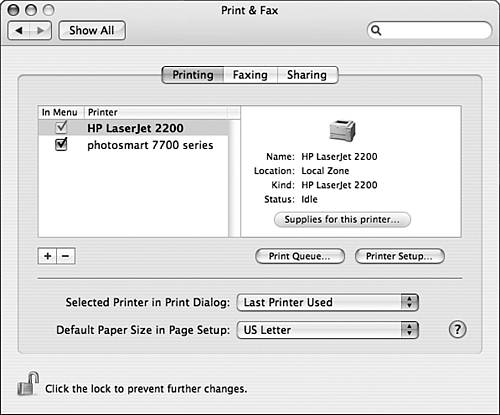
Working with Shared Printers Under Mac OS X, you can share printers connected to your Mac over wired and wireless networks, as well as those connected directly to your Mac through USB. You can also access printers being shared with you. Sharing a Printer Connected to Your Mac To share a printer, perform the following steps: 1. | Install and configure the printer you want to share on your Mac so that it appears on the Printer List.
| 2. | Click the Sharing tab on the Print & Fax pane of the System Preferences application. On this pane, you will see the list of printers configured on your Mac.
| 3. | Click the "Share these printers with other computers" check box. This will activate the printer sharing function.
TIP You can also turn on printer sharing by checking the Printer Sharing check box on the Services tab of the Sharing pane found in the System Preferences application. | 4. | Check the check box next to each printer you want to share (see Figure 30.19). The selected printers will be accessible to other Macs on the same network.
Figure 30.19. The Photosmart printer connected to this Mac can be used by anyone on the same network. 
|
NOTE You can also share printers that are connected to your Mac through a network connection, but you don't need to do this. Instead, just install the network printer on each machine from which it should be available.
When you share a printer, the Mac from which it is being shared must be running for the printer to be available to other computers on the network. If it isn't, the printer won't be accessible to those other Macs. TIP If your network includes an AirPort Extreme Base Station, you can connect a USB printer to the Base Station to share it.
Accessing a Shared Printer To access printers being shared on a network, use the following steps: 1. | Open the Printer Setup Utility.
| 2. | Click Add. The Printer Browser will appear and search for printers with which your Mac can communicate. Printers that are being shared with your Mac will have "Shared Printer" as the connection type.
| 3. | Select the shared printer you want to be able to access.
| 4. | Click Add. The shared printer will be added to the Printer List and you will be able to print with it just like the printers you have installed directly to your Mac.
|
TIP You don't have to perform the previous steps; they just make selecting a shared printer a bit easier. You can actually choose any shared printer via the Print dialog box by first selecting Shared Printers on the list of available printers and then selecting the specific printer to which you want to print.
Printing Under Mac OS X When you print a document, you see the print dialog box for the current printer; the printer shown on the Printer pop-up menu is determined by the preference you set (either the last printer you used or the default). You can choose any other printers that are installed by using the Printer pop-up menu (see Figure 30.20). The Print dialog box contains a variety of pop-up menus and other tools you can use to configure a print job. Figure 30.20. The list of printers available to your Mac, including any that are being shared with you over a network, are shown on the Printer pop-up menu. 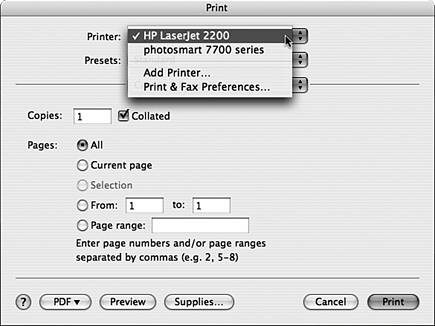
The specific options you see in the Print dialog box depend on the printer you are using and the application from which you are printing. You select the settings you want to configure from the third pop-up menu (counting the Printer and Preset pop-up menus as the first and second ones) and then configure those settings with the controls that appear in the lower part of the dialog box. Depending on the printer and application you are using, the options you have can include the following: Printer You can use this pop-up menu to select a printer to which to print. You can also open the Printer Setup Utility by selecting Add Printer. You can open the Print preferences by choosing "Print & Fax Preferences." Presets You can switch between the standard settings for the selected printer, or you can save a custom configuration and switch to that one. Copies & Pages These controls enable you to set the number of pages you want to print and choose the part of a document you want to print. Duplex If a printer is capable of duplexing, you use these controls to configure it, such as by printing on both sides of the paper. Layout These commands enable you to control how many pages print per sheet of paper, the direction in which your document layout prints, and whether a border is printed. Scheduler This pane enables you to schedule a print job. Paper Feed These controls enable you to select a paper tray for the print job, or you can choose to do a manual feed. Print Settings Controls in this pane enable you to choose a paper type and select from the print modes offered by a printer (such as color, black and white, draft, and so on). Image Quality These controls enable you to determine the quality with which images are printedto save toner, for example. ColorSync This pane enables you to choose ColorSync options for the selected printer. Summary The Summary area displays a description of the print job you have currently configured. This can be useful if you have configured a complex print job and want to check it before you run it.
TIP In the Copies & Pages dialog box for most printers, you have the option to collate documents. If you have ever had to hand-collate a large document, you will really appreciate this feature.
You can preview a print job by clicking the Preview button. When you are ready to print, click Print or press Return. After you have sent a document to a printer, you can check its status by double-clicking the printer on the Printer List in the Printer Setup Utility application to open the printer's status tool; or, when a job is sent to a printer, the Printer's icon opens on the Dock and begins to bounce; you can click this to open a printer to access its status tool (see Figure 30.21). Figure 30.21. You can monitor the status of print jobs by double-clicking a printer in the Printer List or by clicking the Printer's icon on the Dock to open the monitor window for that printer. 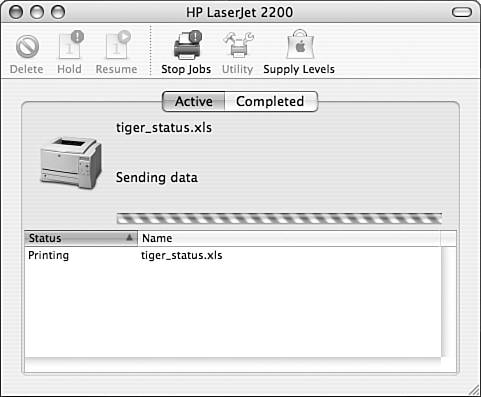
With this tool, you can perform the following tasks: Select a print job on the list and click Delete to remove the job from the queue. Click a print job and click Hold. The printing process will stop. Click Resume and the current job on hold will start printing again. Click Stop Jobs to stop all printing for this printer. Click Start Jobs to start the printer again. Click Utility to open the printer's utility software. Click the Completed tab to view information about print jobs that are complete.
TIP Some additional actions can be useful for some printers. For example, you can click the Supply Levels button to check the amount of ink left in a printer's cartridges if that action is supported by the printer you are using.
|









